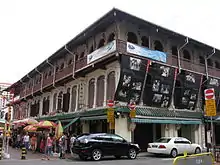Boon Tat Street
Boon Tat Street (simplified Chinese: 文达街; traditional Chinese: 文達街; pinyin: Wén dá jiē) is in the Downtown Core in the Central Area of Singapore. The street extends from Amoy Street at its western end to the junction of Shenton Way and Raffles Quay.

A portion of the street adjacent to Lau Pa Sat is closed in the evening for stalls selling satay. Boon Tat Street has been labeled as a heritage site by the Urban Redevelopment Authority.
Etymology and history
Originally called Japan Street, Boon Tat Street was the first to be renamed by the Municipal Commissioners in 1946 after the Japanese Occupation of Singapore.
The new name commemorated the Singapore-born businessman and former Municipal Commissioner, Ong Boon Tat (Chinese: 王文達; pinyin: Wáng Wén Dá; 1888–1941), the elder son of Ong Sam Leong (Chinese: 王三龍; pinyin: Wáng Sān Lóng). Ong Boon Tat was the proprietor of the New World amusement park in Jalan Besar. Ong extended his father's business and was the owner of brickworks, sawmills and rubber estates. In the 1920s, he was described as "one of the group of young Straits Chinese who is taking a practical interest in public affairs, having realised the duties of citizenship which devolve more especially on the men of education and standing in our community".
The Hokkiens refer to this street as ma cho kiong pi, meaning "beside the ma cho temple", referring to the Thian Hock Keng temple at Telok Ayer.
References
- Victor R Savage, Brenda S A Yeoh (2004), Toponymics – A Study of Singapore Street Names, Eastern University Press, ISBN 981-210-364-3
